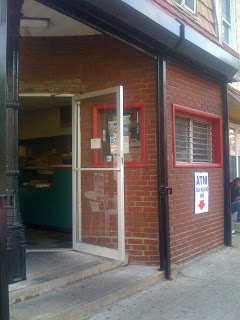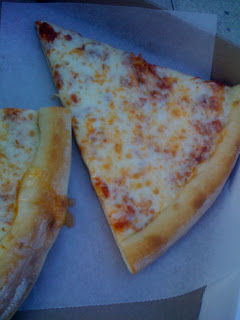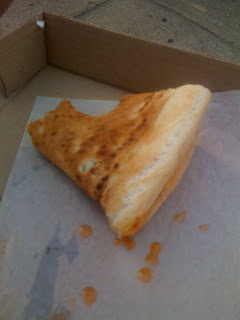I really want to go back through this and understand all of it again. I really enjoyed writing these.
Cold
My old shop. Truckee, CA, 2007. It was too small with the door closed to move around, and anyway it was unheated, so I would open it up and revel in the abject humor of the whole thing. I thought this photo (which I orchestrated with a tripod, etc.) was hilarious.
Bacon Gone
My Grandfather, Libo (for whom my German Shepherd is named) wrote this circa 2007. We were sitting around chatting and he jotted a few similar verses as we talked. I continue to think it's hilarious.
Basically the best tweet ever
from the brilliant Dave Shumka.
Parks
via I Love Charts; available for purchase on Jeremy Huggins' site.
From the Archives: Pizza, Philly, 2008
In 2008, I was living in Philly and decided to start a blog about all the pizza I was eating. Suffice it to say that it never took off (I composed six posts over a three month period before drifting away from the idea), but I like some of the writing. Below is my (slightly edited) review of El Greco, a totally crappy joint near the totally crappy workspace I kept in North Philly. It was originally posted 2008.05.30. I particularly like the last paragraph, which sums up my feelings about slice shops well.
El Greco is a neighborhood shop, and it's just a few blocks from my workshop. I stop by every once in a while, and it's an experience.
Today, as usual, there were a bunch of people inside. Three behind the small (but tall) counter, a driver or two outside, and three or four customers in the long, narrow area inside. I order two slices, which are put in a box. (A bit of a downer for me - what, they don't want me eating in front of the shop? Put it on a plate, please...) I go outside and stand by my bike and eat them - warm, gooey, and very sweet. The cheese is thick and chewy, the crust is soft and light, and the sauce is sugary and squirmy.
The slices are floppy - they fold, and don't crease - and drip red-orange oil as I squeeze the fluffy crust to keep the whole package together. The first bite requires me to hold the crust side above the rest of the slice, so that it doesn't unfold and go limp. Eating the slices produces a texture that resembles, almost, mollusks. As I stand there eating, I observe the scene. A tall, gaunt man sits on the stoop, then stands and mills around the storefront, smoking a cigarette. Three customers who came out of the shop just as I was entering sit on a stoop next door eating their slices and talking. The traffic on 2nd St. whizzes by, passing the small community at Jefferson - the slice shop, an auto tag store and a barbershop.
I like El Greco in a way. It's not exactly gourmet, but talking about the quality of the food misses the point of the business. It isn't high quality - some might go so far to argue that it's hardly pizza. Either way, it's food, it's part of a neighborhood. And sometimes that's all you need.
Rack Ends: Background, Requirements & Design
In the past few weeks, I've been reviving a product that I originally conceived of in 2010. I'll get more into its revival later, but I wanted to spend a little time documenting the development and design details here.
It was sometime in 2009 that I decided that rackbuilding was something I wanted to focus on. I had been building custom bike frames full-time for a year and a half, and had developed a sense that for most customers, custom frame geometry alone is just not sufficient reason to justify spending $3K+ on a bike. I had built a few nice road and mountain bikes in the $5-7K range, and I was proud of the results, but the value proposition for most customers just wasn't there. For that money, you can buy one hell of a Specialized off the rack at a LBS. And other than a sotto voce paint job (I tend to *hate* the design language that the big bike companies use), there was little I could offer to really distinguish myself.
I also wasn't totally immune to spotting trends. In March of that year, I attended a trade show and spent a while observing the way other folks were differentiating themselves. Fashion in the handmade cycling world tends towards the quaint, and rackbuilding offers framebuilders the opportunity to show their bikes carrying things like wine bottles and six-packs - stuff that most big companies would never display.
Around this time, I was living in Philadelphia and spending a lot of time biking around and eating pizza. I spent a while thinking about what kind of rack I'd want for my bikes, and the best combination of whimsy and utility that I could come up with was a front rack that would fit a large pie. I was riding around a hardtail mountain bike at the time, and decided to build up what would become The Utility Bike - and, once it was mostly done, went about building my first real rack.
At the time, most custom builders were just cutting their own rack eyes out of plate or bar stock (Rack Lady, who I have a *lot* of respect for, is/was a great example of this). A few folks (Signal stands out) were doing really beautiful things that more closely emulated lugged construction, but that was never really my aesthetic. Anyway, I wanted my rackbuilding process to be TIG only.
I started by having a bunch of plate-style eyes watercut from a sheet of stainless plate. The plate was .125" thick and came with a stain finish. The result was a pretty good start.
I used these on a couple of racks, and all in all they were a great improvement over cutting them by hand. I tried a few different methods. In at least one case I crimped the rack tubing over the tab itself, but it was a bit cleaner to slot the tubing and insert the tab into the slot. Welding the whole thing together was a bit sloppy (The wall thickness on the rack tubing is .028", which contrasts badly with the .125" thick plate eyes. The result is that keeping both parts right at melting temperature is tricky.) , but the result was passable.
This was my first nice rack. I eventually got Ian to make me some slats to fill in the deck and, and I made some custom length bungees too. I learned a lot in the process, and also tried out a detail that - although kind of silly - would end up informing the way my rack end design progressed. The rack required that a few tubes be terminated, and I turned down some solid stock to a point, relieved an area to insert into the tube, and lap welded the entire thing together. The result is below.
Right around this time, I started building bikes for both Saylor and Ian. Both required racks, and Ian got a chainguard as well. I spent a little while thinking about how to terminate all the tubing, and ended up making a batch of mill-turned rack ends that would become my go-to solution on a bunch of future projects. The process went turn-mill-turn, and included at least ten processes per part, described roughly below:
The end result can be inserted into a piece of .375"x.028" tubing (cut square) and lap welded. I generally would then file and sand the result smooth. This assembly technique offered me a key feature: If a strut was just slightly too long, I would shorten it (by rolling it against a benchtop disc sander) quickly and in small increments. In addition, the entire assembly is self aligning - the rack end bolts to the boss and slips into the tube, which can have any orientation necessary. This method was much easier than if I had been using tabs & slots, which take a lot of work to align just right and is difficult to adjust the length of.
I got a lot of mileage on these parts, and adapted them for a few alternate configurations as well. I developed something of a symbiotic relationship between their design and my rackbuilding workflow, and the result has been (to me) great.
I think these parts could be useful to a lot of framebuilders out there, and I'd be interested to hear from anyone who might be interested in them. Drop me a line if that sounds like you.
Hardtail
2008.
I want this bike back.
Three iterations of a mountain bike I built in 2007.
Breather holes
A chart I drew early in 2010 showing breather holes on the various frame parts of The Realster.
One of many
Looking through old photos from a different lifetime (or not?).
A weird translation
From a message on mfg.com that I received the other day (emphasis mine):
Hi Spencer,
Have a nice day. We are very interested in you project.
Could you advise your precious about our quote?
We sincerely hope to build a long-term cooperation relationship with you. We have been specialized in this area for several decades of years. And we have gotten ISO certificate. We always provide high-quality parts with reasonable price to our clients, you could check our good rating commented by our clients. Hope starting work with you soon. Look forward to hearing from you soon.
Any doubt, please feel free to contact us at anytime.
Many thanks&Kind regards
[NAME REDACTED]
I can't for the life of me tell what they mean by this. Who is my precious?
For anyone interested in these types of mistranslations, you should really check out Language Log's "Lost in Translation" posts.
Man From Mars
When I got out of college, I spent two years in construction management in Northern California. It was a stressful period for me - I was out of my element, alone, and over my head - and I struggled to fit in with the employees and subcontractors that I dealt with on a day-to-day basis.
It was towards the end of this time that I heard Tom Wolfe's 1987 interview with Terry Gross, in which he described the benefits of standing out. It's something that's stuck with me since. Emphasis below is mine.
Wolfe: I have discovered that for me - now, maybe it doesn't work for everybody - for me, it is much more effective to arrive at any situation as a man from Mars than to try to fit in.
When I first started out in journalism - in magazine work, particularly - I used to try to fit in. I remember doing a thing on stock car racing. I went down to North Wilkesboro, North Carolina, to do a story on a stock car racer named Junior Johnson. And I tried to fit in to the stock car scene.
I wore a green tweed suit and a blue button-down shirt and a black knit tie and some brown suede shoes and a round Borcelino hat. I figured that was really casual, it was the stock car races.
And after about five days, Junior Johnson, whom I was writing about, came up to me. He says, I don't mean to be rude or anything, he says, but people I've known all my life down here in Ingle Hollow - that was where he came from - he said, they keep asking me: Junior, who is that little green man following you around?
And it was then that it dawned on me that A, nobody for 50 miles in any direction was wearing a suit of any color; or a tie, for that matter; or a hat. And the less said about brown suede shoes, the better, I can assure you. So I wasn't - you know, I wasn't fitting in to start with.
I was also depriving myself of the ability to ask some very obvious questions if I thought I fit in. I was dying to know what an overhead cam was. People were always talking about overhead cams, but if you were pretending to fit in, you can't ask these obvious questions.
After that, I gave it up. I turned up - always in a suit and, you know, many times a white suit, and just be the village information-gatherer. And you'll be amazed, if you're willing to strike that role.
GROSS: When you were doing the research for your book "Electric Kool-Aid Acid Test," which is about Ken Kesey and the psychedelic acid trips, were you dressed like that, too?
WOLFE: Oh, yes. And actually, to have tried to fit into that scene would have been fatal - perhaps literally, fatal.
Kesey had this abiding distaste for pseudo-hippies or hipster -there was really no such term at that time, but we'll just call them pseudo-hipsters - you know, the journalist or the lawyer or teacher who on the weekends, puts on his jeans and smokes a little dope and plays some Coltrane records, and tries to be part of the scene.
And so he had a device called testing people's cool. And I remember once witnessing this. It was on one of these weekends. And he said: All right, let's everybody get nekkid(ph) - that was his word for naked - and get on our bikes and go up Route 1. This was in California.
And they did. They took off all their clothes, they got on their motorcycles, and they started riding up Route 1. Now, this separated the hippies from the weekend hipsters, if you will, very rapidly. But now, I didn't have to worry because I was in my three-piece suit with a big, blue corduroy necktie. And the idea that I was going to take any of this off for anybody was crazy.
Relax.
From a great Language Log post.
Climb.
from Kevin Shea Adams.
Photo-ish
From ffffound!
Photo
Name Three
From Less Wrong, emphasis mine.
Even with people who've had moderate amounts of exposure to Less Wrong, a fair amount of my helping them think effectively often consists of my saying, "Can you give me a specific example of that?" or "Can you be more concrete?"
A couple of formative childhood readings that taught me to be specific:
"What is meant by the word red?"
"It's a color."
"What's a color?"
"Why, it's a quality things have."
"What's a quality?"
"Say, what are you trying to do, anyway?"
You have pushed him into the clouds. If, on the other hand, we habitually go down the abstraction ladder to lower levels of abstraction when we are asked the meaning of a word, we are less likely to get lost in verbal mazes; we will tend to "have our feet on the ground" and know what we are talking about. This habit displays itself in an answer such as this:
"What is meant by the word red?"
"Well, the next time you see some cars stopped at an intersection, look at the traffic light facing them. Also, you might go to the fire department and see how their trucks are painted."
-- S. I. Hayakawa, Language in Thought and Action
and:
"Beware, demon!" he intoned hollowly. "I am not without defenses."
"Oh yeah? Name three."
-- Robert Asprin, Another Fine Myth
And now, no sooner does someone tell me that they want to "facilitate communications between managers and employees" than I say, "Can you give me a concrete example of how you would do that?" Hayakawa taught me to distinguish the concrete and the abstract; and from that small passage in Asprin, I picked up the dreadful personal habit of calling people's bluffs, often using the specific phrase, "Name three."
Post Hoc Perfect
From Christopher Chabris' review of Duncan Watts' "Everything is Obvious," emphasis mine.
Common sense is also inclined to conclude that individual successes (and failures) are determined by inherent qualities rather than by unpredictable circumstance. Mr. Watts asks why the "Mona Lisa" is the most admired painting in the world today—why most people believe it to possess unique, timeless features that set it apart.
Before the 20th century, the "Mona Lisa" wasn't even the most popular painting in the Louvre. But in 1911 it was stolen, smuggled to Italy and exhibited widely before being returned to France, whereupon Marcel Duchamp defaced a reproduction of it and labeled his work with an obscene pun. The painting rocketed to fame, its pigments and brushstrokes unchanged. The "Mona Lisa" is the artistic equivalent of the investor who did nothing special until he got lucky a few years (or quarters) in a row and was fêted as a genius.
Connections
From "The Happiness Advantage," quoted (in a great post) by Eric Barker, via Michael Galpert.
...when MIT researchers spent an entire year following 2,600 employees, observing their social ties, even using mathematical formulas to analyze the size and scope of their address books and buddy lists, they found that the more socially connected the IBM employees were, the better they performed. They could even quantify the difference: On average, every e-mail contact was worth an added $948 in revenue.









































